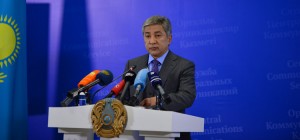 ASTANA – Akim (Mayor) Imangali Tasmagambetov presented a report on the capital’s development at a Central Communications Service (CCS) briefing at the end of December, describing the city’s development and its challenges in dealing with a population that is growing more quickly than anticipated.
ASTANA – Akim (Mayor) Imangali Tasmagambetov presented a report on the capital’s development at a Central Communications Service (CCS) briefing at the end of December, describing the city’s development and its challenges in dealing with a population that is growing more quickly than anticipated.
According to the mayor, Astana’s achievements are substantial. The city’s gross regional product (GRP) grew by 7 percent last year, and Astana now accounts for 9.4 percent of Kazakhstan’s gross domestic product (GDP).
The GRP increase in 2013 continues the city’s decade-long trend of stable growth. In 2002, Astana’s GRP value was about 231 billions tenge (about US$1.5 billions at current exchange rate). After growing gradually from 2003-2006, GRP approached 1 trillion tenge (US$6.47 billions). Since then, according to the Statistics Agency of Kazakhstan, Astana’s GRP has more than doubled and surged to about 2.5 trillion tenge (US$16.18 billion) by the end of 2012.
The growth in 2013 was mainly attributed to developments in the machinery and metallurgy sectors, where production increased by 40 percent and 46 percent respectively. In 2013, the implementation of the State Programme of Industrial and Innovative Development (SPAIID) resulted in the launch of 19 new projects with a total value of more than 87 billion tenge (US$563 million). This was double the number of projects of the previous year and a 20 percent increase in project value.
As key milestones are passed, the capital is shifting its attention to new priorities, Tasmagambetov said. Along with continued infrastructure development, the city is implementing a number of investment projects in the energy sector. Its existing two power stations are being modernised and another power station is under construction.
Housing construction is also seeing high growth. “Annually, we commission more than 1 million square metres of new housing. In 2013, 1.1-1.2 million square metres of housing were to be commissioned. In total, 12 million square metres of housing were built and put into service over the period of Astana’s development,” the mayor reported.
With strong economic growth comes a strengthening of the city’s tax administration. According to Tasmagambetov, these efforts are to result in better budget revenue fulfilment, which will make Astana a net donor to the national budget in 2015, rather than a recipient of state budget resources.
Astana’s dynamic development seems to be making it an increasingly attractive place to live. The mayor noted that “more than 50,000 people arrive in the capital every year. For example, since the beginning of [2013], public service centres registered 101,283 people who arrived from other regions of the country, while only 22,747 people left the city. This means that more than 78,000 new people settled in Astana.”
Overall, the city’s population has grown from 280,000 when the capital was relocated in 1997 to 800,000 at the end of last year. The growth is due both to migration and a high birth rate.
This growing young population will require the construction of new kindergartens, schools and clinics. The mayor reported that now, about 60 percent of children under six years of age don’t attend preschool, and there are long waiting lists for spots in kindergartens. In 2014, the city plans to commission 17 more preschool institutions. By 2020, the administration plans to commission 100 preschool institutions.

